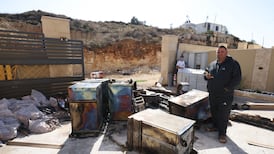Israel’s military forcibly entered a clearly marked UN base and is suspected of using the incendiary chemical white phosphorus close enough to injure 15 peacekeepers, according to a confidential report outlining a dozen recent incidents in which the IDF attacked international troops in Lebanon.
The report – prepared by a country that contributes troops, and seen by the Financial Times – underscores how Israeli troops have targeted Unifil, the UN-mandated force deployed along the de facto border between the countries, on multiple occasions. They have damaged several facilities and caused injuries to troops stationed at border posts in southern Lebanon.
Unifil has called these incidents a “flagrant violation of international law”.
Israel has rejected accusations that it has deliberately targeted Unifil since it launched its ground invasion into southern Lebanon in the early hours of October 1st. The Israeli military had not responded to a request for comment by publication time.
RM Block
Israel has also said that UN forces are being used as a human shield by Hizbullah fighters, which it is fighting near several Unifil posts along the border. It has demanded the UN evacuate its peacekeepers from southern Lebanon for their own safety. Unifil, and the 50 countries that contribute troops to its ranks, including Ireland, have unanimously refused.
The attacks have drawn international condemnation. But Israel has stood firm. On Sunday, Unifil said an Israel Defense Forces bulldozer deliberately demolished an observation tower and perimeter fence of a UN position in Marwahin.

Unifil has made public most incidents referenced in the confidential report, but it provides further details and includes photographs documenting the extent of the damage done to bunkers that shelter troops, perimeter walls and observation towers at several bases.
While incidents in the first few days were mainly near UN positions, the report says Israeli forces began directly firing on to Unifil bases after October 8th.
In one incident on October 10th, two peacekeepers were injured when an IDF Merkava tank fired at an observation tower at the international force’s headquarters in Naqoura, directly hitting it and causing them to fall.
A photograph in the report shows a large circular hole in the tower, which Richard Weir, a senior conflict and arms researcher at Human Rights Watch, said was consistent with direct fire.
In another incident on October 10th, the IDF fired at a UN bunker where Italian peacekeepers had taken refuge in Labbouneh.
The report says the bombardment of the entrance to the bunker happened after the IDF had conducted drone surveillance operations and destroyed the position’s cameras the day before. Photographs in the report show a large mound of debris tumbling under a hole in the corner of a building.
In the early hours of October 13th, Unifil said two IDF Merkava tanks broke through one base’s main gate. Following Unifil protests, the tanks left after 45 minutes. But within an hour, several rounds were fired about 100m north of the base, which emitted “smoke of suspected white phosphorus” that wafted into the base, the report said, injuring 15 peacekeepers.
Photographs in the report showed the tanks rolling over the gates and into the base, damaged perimeter walls and white smoke lingering throughout.
The IDF acknowledged that one of its tanks had backed “several metres” into the Unifil post. But it said the tank was trying, under fire, to evacuate injured soldiers. The IDF added that a smoke screen had been created to provide cover.
Even if clashes occurred in the area, those tanks “can withstand fire better than our position can. So if they were sheltering, it wasn’t for physical shelter”, said a Unifil source.
Rights groups have documented Israel’s use of white phosphorus in Lebanon throughout the past year. Its use is unlawful in populated areas under international law, but it is frequently used as a military tool to obscure, or as a weapon to smoke out opposing forces, Mr Weir said.
Israel has previously defended its use of white phosphorus as consistent with international law. – Copyright The Financial Times Limited 2024
- Sign up for push alerts and have the best news, analysis and comment delivered directly to your phone
- Join The Irish Times on WhatsApp and stay up to date
- Listen to our Inside Politics podcast for the best political chat and analysis



















